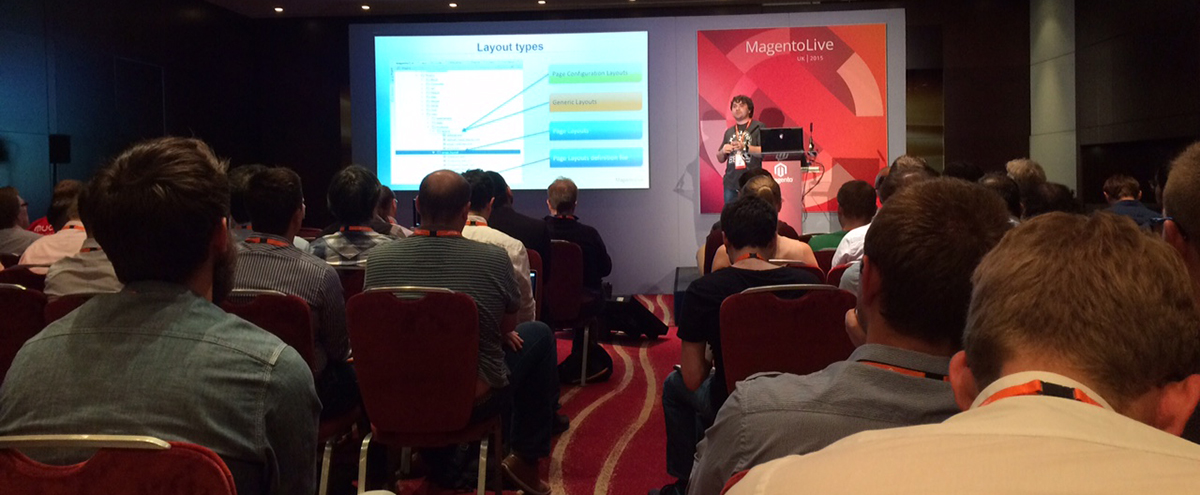June 22nd-23rd 2015 marked the fourth annual Magento Live UK event in London, the fifth if you include the original “Meet Magento” all those years ago. No UK Magento event would be complete without my thoughts and ramblings in accompaniment.
This year, myself (@adampmoss, @magentofox) and Creare Technical Director James Bavington (@jamesbavington) were in attendance for Magento Live UK 2015 at the Park Plaza Westminster Bridge – a great venue. There ‘s few better places in London to spend 12 hours underground on a hot, sunny June day. We arrived about midday on Monday, just in time for the Developer Deep Dive.

(Monday)
Developer Deep Dive, 1:30pm – 4:30pm
I’m no doctor, but I’m fairly sure that sitting in the same position for 3 hours straight does no favours to one’s arse. Luckily for me and my soon-to-be-concrete backside, the content of the session was well worth sitting through. The session was hosted by everyone’s favourite Magento evangelist and former Magento U trainer, Ben Marks.
Magento Performance Issues? FIX Them, Don’t Mask Them – Luke Fowell
Luke’s talk was about optimising your PHP to prevent unnecessary load on the database. It was all fairly basic stuff, but so important for developers to bear in mind when customising Magento as this is the leading cause of slow Magento websites. His recommendations included:
- Not loading models within loops
- Using setPageSize on collections to limit MySQL queries
- Using single quotes rather than double quotes
- Disable debugging
- Using the “===” operator rather than “==”
Customising Magento is the leading cause of slow Magento websites
He also mentioned using profilers such as the one built into Magento or XDebug to investigate where the problems crop up in the code. I feel sorry for anyone who tries to debug Magento without the use of profilers.
Preparing to Work With Magento 2Â -Â James Cowie
Aside from installing Magento 2 RC and playing around with the admin, I’ve not had time to delve into the code of Magento 2 yet (that’s my next 3 months sorted then). James’ presentation was a nice introduction to how Magento 2 works with Dependency Injection, something that is used instead of the traditional Mage god class. It makes testing much easier and greatly improves code transparency. I recommend reading this article to learn more: Magento 2 Dependency Injection
The Northerner rounded off by recommending PHPSpec for unit testing.
Dependency Injection makes testing much easier and greatly improves code transparency

Magento 2 Web Developer’s Workflow - Vitaliy Korotun
I’ve watched him at previous conferences and I want to say that I like Vitaliy’s presentation style. His informative dialogue combined with tongue-in-cheek goofiness is always entertaining to watch. He gave us a ‘deep dive’ of Magento 2’s new file structure, location of assets and how theming has changed since M1. These were the key takeaways about theming:
- All theme files are now contained within the module directory, which makes modules easier to ship.
- The skin folder is no longer
- The awesome introduction of theme variables set in the layout XML – using $this->getVar()
- Page layouts are defined in frontend/layouts.xml
- The introduction of <container> nodes in layout XML
- Templates use $block variable instead of $this as the template is no longer compiled within the block class
- Magento 2 uses LESS by default, but can be reconfigured to user other CSS preprocessors like Sass
- JS framework built around require.js, pages only load the compiled JS needed for those pages with ‘bundles’
- Ability to instantiate JS classes within HTML, e.g: <div id=“toolbar’ data-mage-init=‘{“toolbarEntryâ€:{}}’>
- The page layout XML elements looks almost like HTML:

Magento 2 uses LESS by default, but can be reconfigured to user other CSS preprocessors like Sass
Code Customization on Magento 2Â -Â Anton Kril
Anton Kril gave a pretty detailed introduction into how Magento 2 can be customised and extended using the new framework capabilities. The biggest introduction into the core is the Service Contracts layer which allows different modules interact with each other via PHP interfaces. I don’t have time to go into detail, but this blog post by Alan Kent gives a good breakdown of everything: Magento 2 Service Contract Patterns
It was well presented, but for someone like me with little knowledge in this area yet it was perhaps a bit too advanced. I literally need to go back to basics before I start developing Magento 2 modules.
Magento 2 Performance and Scalability  - Ted Pietrzak
The final talk of the developer deep dive was provided by Texan Ted Pietrzak who gave us a dissection of Magento 2’s performance enhancements. Ted’s soft-spoken drawl was cooler than the other side of the pillow and should be enough to convince even the hardest sceptic of Magento 2’s speed improvements. The presentation was backed-up by a series of graphs that you can look through here: Magento 2 Performance & Scalability
Here are the key takeaways:
- Magento 2 is 25% faster out of the box than M1 (15% on catalog browsing, 45% adding to cart)
- Improvements to speed are still a work in progress
- Big DB requests have been made smaller
- Eliminated unnecessary DB requests
- Reusable objects have been cached
- Client side there is now an AJAX add to cart, no longer any inline JS, minification of JS/CSS/HTML at compilation stage, better image compression, JS bundling and more..
Magento Kick Starter, 5:30pm
We decided to attend a workshop help by Deryck Harlick  from MageTraining and Brent Peterson from Wagento. The aim was to setup a Magento store and start selling in 90 minutes. It covered most of the basic admin stuff that I have to go through when I train staff and clients, so it was nice watching someone else do it for a change. It was aimed at merchants rather than developers, but was still fun to watch.
Despite the efficiency of the presentation I don’t think we’ll be using 90 minutes as a suggested lead time for customers going forward!
Opening Night Networking Event, 7pm ’til late
So we’ve had pool tables, arcade machines, table tennis and girls on rollerskates. We can now add casino night to that list as Magento attempted to bring a bit of Imagine’s Vegas charm to London. Luckily no real money was involved so I didn’t have to spend the night on the streets of Waterloo.

(Tuesday)
Registration & Breakfast, 8am
Magento, those breakfast croissants were sublime. Bravo!
Pitchfest, 9am
The pitchfest was basically half an hour of various companies coming to the stage to sell themselves in 90 seconds. I liked the fast-paced nature of the session but it was otherwise a bit uninteresting.
Startup Success, 9:45am
The startup success session was engaging and featured 3 success stories from 2 merchants who chose to use Magento, and the Magento community’s very own Ignacio de Paula who gave us a detailed account of how Ebizmarts grew as a company. It was interesting to hear how their product and service offering changed so many times over the course of their history. The key is to keep your product base simple and manageable.
I came away with some great insight and information on how to go about setting up your business. The overwhelming takeaway from this session is that you should focus initially on a niche and grow organically. If you can find a niche then you can get your foot in the door of a market and use Magento as the platform to help you grow your business.
The takeaway from this session is that you should focus initially on a niche and grow organically
Your product base should be manageable but at the same time you need more than 1 product to sell as Christopher Ward’s Mark Bennett reiterated. He also made a point about protecting your brand – there’s no need to be so cheap that it affects the brand values you’ve worked hard to achieve.
General Session I, 11:30am
The day’s general sessions were presented by Ben Pressley, Head of Worldwide Sales for Magento. His first talk focused on how businesses should achieve excellence in customer service in order to differentiate themselves in their respective markets.
The next guy to take to the stage was Gordon Henderson from AXA insurance who delivered a humorous and at times controversial account about how AXA have changed how they approach to life insurance. His remarks about targeting Afghanistan as a growth opportunity for life insurance drew nervous laughter from the audience. Anyway, in the wake of a new (supposedly) healthier society, AXA have used Magento to offer a range of health products and services.
80% of businesses aspire to be leaders in customer experience, but only 11% actually deliver
Breakout Sessions, 1:30am
I only attended 1 breakout session in the afternoon, and that was the one delivered by Kath Pay titled Creating a Successful Customer Journey. It featured the results of several interesting A/B tests carried out by various ecommerce companies. The psychology behind UX is something that interests me a great deal. I’ve listed a few of the main points below:
- Use reciprocity to encourage users to sign up. For example, Â “10% off your first purchase”
- Use cognitive easing throughout your site – this means using visual cues to guide the user’s attention. This could include arrows, lines or even people in your images looking towards the area of action (see below)

- Loss aversion is also another good technique to use in your email marketing and promotional material on your site. Lines like ‘1 day left’ will help convince people they cannot afford to miss the offer.
- Hick’s Law states that giving users too much choice is a bad thing, try not to offer too many products at once
- Use emotion to get your users emotionally invested in your offer. The way you word your emails and promotions can make a real difference. Use words that evoke an emotional response (such as memories of better times).
- Call to actions should be worded appropriately. The word ‘submit’ is not very descriptive or reassuring to a user.
Use visual cues to guide the user’s attention. This could include arrows, lines or even people in your images looking towards the CTA
General Session II, 1:30am
The second general session of the day really got into the nitty gritty of where Magento is right now as a company. Ebay Enterprise President Craig Hayman, whose Anglo-American accent could make Madonna jealous, was the man at the helm to deliver the initial keynote. Here are the latest stats about Magento:
- Â 240,000 Customers
- 4,500+ Certified Developers
- 300+ Partners
- Operating out of 15 countries
- 28% share of the top 100,000 sites in the Alexa 1M
We then saw a video of how toymaker Hornby have transformed their online business since switching to Magento Enterprise. The video was so well done it made me want a model train set of my own! A Nestle spokesman also discussed how they have distributed their new BabyNes range into 30 markets in 18 weeks in 2015 through their Magento website. 30 international markets in 18 weeks…? Someone at Nestle deserves a pay rise.
Magento U
Some awesome news coming out of Magento was that Leeds Beckett University is now offering Magento training courses at their tech institute. In addition to this there are a host of Magento 2 training courses available now and on the horizon:
- Fundamentals of Magento 2 Development – On Demand | Units 1-3 (available now)
- Fundamentals of Magento 2 Development – On Demand | Units 4-5 (August 2015)
- Classroom Delivery (October 2015)
- Frontend Training (September 2015)
- Managing your Magento 2 Store (October 2015)
Magento 2
Firstly, it’s worth pointing out that Magento 1 will continue to be supported following the release of Magento 2 with several patches and releases on the horizon. The Magento 2 roadmap was shown to us by Head of Product Management, Paul Boisvert. The good news is that all targets have been hit so far and the Q4 2015 GA release is still very much on track.

In addition to the release of Magento 2 GA, Magento confirmed they are working with all the big players in the extension marketplace to get their extensions ready for the Magento 2 launch (including ourselves).
There’s also a data migration tool available for migrating product and customer data from your M1 store to your new M2 store – this will not be able to export any theme data though.
Magento Connect
We were treated to a flashy video showing the features and improvements made to the new version of Magento Connect which is due for release in the near future. Myself and many other community members have felt frustrated with the old Magento Connect for a long time, in particular the fairness of the review system. The new Magento Connect promises a new review system which is fair and transparent. It will also provide in-depth analytics on the number of downloads and sales that have been made.
Myself and many other community members have felt frustrated with the old Magento Connect for a long time
The best part though is that it looks much better. A clean and informative design replaces one which has grown slow and tired after years of disservice.
Magento Small Business
*Drum roll*……… The new small business partnership program was briefed to the audience and Creare was mentioned among the companies currently participating! Our pride at seeing the company logo up there during the keynote was so big it pretty much needed its own seat. Creare is one of Magento’s SMB ‘do-it-for-me’ partners – you can find us and the other companies mentioned here: Magento Small Business

Summary
Another great conference put together by Magento. The content was very engaging this year and it was great to catch up with the Magento Community. As a side-note I was also delighted to hear the positive response that CreareSEO is getting from almost everybody we spoke to. Going forward, we have decided to dedicate much more time to improve and support this extension to help make it the #1Magento extension for SEO. I’d also like to give a shoutout to the guys at Webshopapps for their continued support via social media.
Things are looking really good for Magento, the customers and the community. The story will surely have moved on considerably at next year’s conference.
